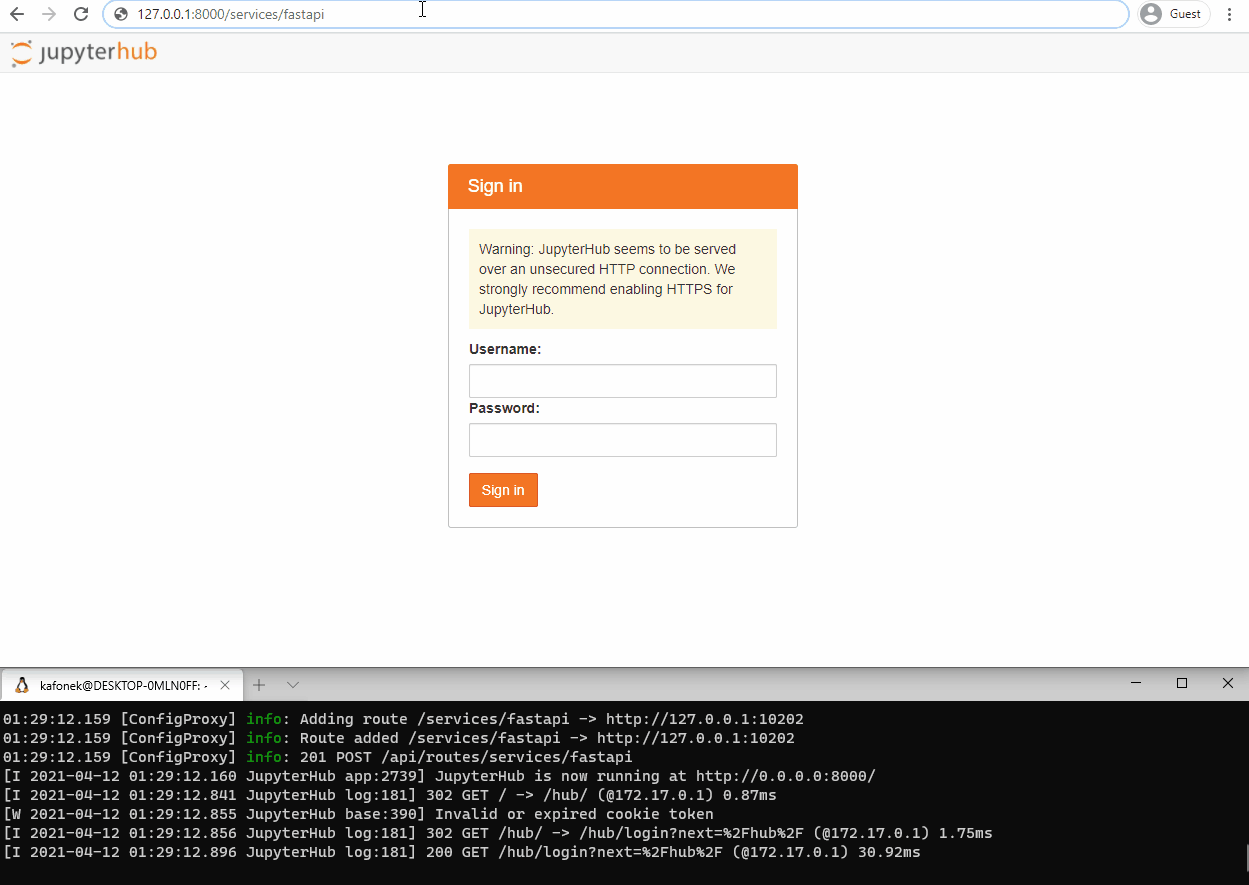Fastapi
FastAPI is a popular new web framework attractive for its type hinting, async support, automatic doc generation (Swagger), and more. Their Feature highlights sum it up nicely.
Swagger UI with OAuth demo
Try it out locally
- Install
fastapiand other dependencies, then launch Jupyterhub
pip install -r requirements.txt
jupyterhub --ip=127.0.0.1
-
Visit http://127.0.0.1:8000/services/fastapi or http://127.0.0.1:8000/services/fastapi/docs Login with username 'test-user' and any password.
-
Try interacting programmatically. If you create a new token in your control panel or pull out the
JUPYTERHUB_API_TOKENin the single user environment, you can skip the third step here.
$ curl -X GET http://127.0.0.1:8000/services/fastapi/
{"Hello":"World"}
$ curl -X GET http://127.0.0.1:8000/services/fastapi/me
{"detail":"Must login with token parameter, or Authorization bearer header"}
$ curl -X POST http://127.0.0.1:8000/hub/api/users/test-user/tokens \
-d '{"auth": {"username": "test-user", "password": "mypasswd!"}}' \
| jq '.token'
"3fee13ce6d2845da9bd5f2c2170d3428"
$ curl -X GET http://127.0.0.1:8000/services/fastapi/me \
-H "Authorization: Bearer 3fee13ce6d2845da9bd5f2c2170d3428" \
| jq .
{
"name": "test-user",
"admin": false,
"groups": [],
"server": null,
"pending": null,
"last_activity": "2021-05-21T09:13:00.514309+00:00",
"servers": null,
"scopes": [
"access:services",
"access:servers!user=test-user",
"...",
]
}
Try it out in Docker
- Build and run the Docker image locally
sudo docker build . -t service-fastapi
sudo docker run -it -p 8000:8000 service-fastapi
- Visit http://127.0.0.1:8000/services/fastapi/docs. When going through the OAuth flow or getting a token from the control panel, you can log in with 'test-user' and any password.
PUBLIC_HOST
If you are running your service behind a proxy, or on a Docker / Kubernetes infrastructure, you might run into an error during OAuth that says Mismatching redirect URI. In the Jupterhub logs, there will be a warning along the lines of: [W 2021-04-06 23:40:06.707 JupyterHub provider:498] Redirect uri https://jupyterhub.my.cloud/services/fastapi/oauth_callback != /services/fastapi/oauth_callback. This happens because Swagger UI adds the request host, as seen in the browser, to the Authorization URL.
To solve that problem, the oauth_redirect_uri value in the service initialization needs to match what Swagger will auto-generate and what the service will use when POST'ing to /oauth2/token. In this example, setting the PUBLIC_HOST environment variable to your public-facing Hub domain (e.g. https://jupyterhub.my.cloud) should make it work.
Notes on security.py
FastAPI has a concept of a dependency injection using a Depends object (and a subclass Security) that is automatically instantiated/executed when it is a parameter for your endpoint routes. You can utilize a Depends object for re-useable common parameters or authentication mechanisms like the get_user pattern.
JupyterHub OAuth uses a token, which can be passed in two places: a token url parameter, or an Authorization: Bearer <token> header. FastAPI has helper functions that let us create Security (dependency injection) objects for each of those. When you need to allow multiple / optional authentication dependencies (Security objects), then you can use the argument auto_error=False and it will return None instead of raising an HTTPException.
Endpoints that need authentication (/me and /debug in this example) can leverage the get_user pattern and effectively pull the user model from the Hub API when a request has authenticated with cookie / token / header all using the simple syntax,
from .security import get_current_user
from .models import User
@router.get("/new_endpoint")
async def new_endpoint(user: User = Depends(get_current_user)):
"Function that needs to work with an authenticated user"
return {"Hello": user.name}
Notes on client.py
FastAPI is designed to be an asynchronous web server, so the interactions with the Hub API should be made asynchronously as well. Instead of using requests to get user information from a token/cookie, this example uses httpx. client.py defines a small function that creates a Client (equivalent of requests.Session) with the Hub API url as it's base_url and adding the JUPYTERHUB_API_TOKEN to every header.
Consider this a very minimal alternative to using jupyterhub.services.auth.HubOAuth
# client.py
import os
def get_client():
base_url = os.environ["JUPYTERHUB_API_URL"]
token = os.environ["JUPYTERHUB_API_TOKEN"]
headers = {"Authorization": "Bearer %s" % token}
return httpx.AsyncClient(base_url=base_url, headers=headers)
# other modules
from .client import get_client
async with get_client() as client:
resp = await client.get('/endpoint')
...
